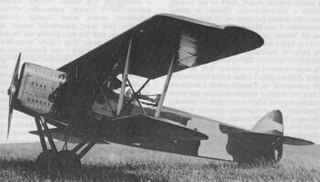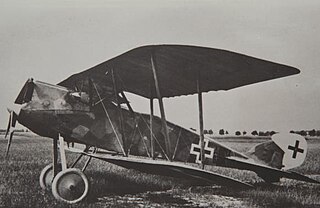Related Research Articles

The Dornier Do 23 was a German medium bomber of the 1930s.

The AEG G.I was a three-seat, twin-engined German biplane bomber aircraft of World War I. It was tested and found to be viable for air-fighting in the latter half of 1915 but performed poorly, necessitating the development of the AEG G.II.

The Aero A.11 was a biplane light bomber and reconnaissance aircraft built in Czechoslovakia between the First and Second World Wars. It formed the basis for many other Czechoslovakian military aircraft of the inter-war period. Around 250 were built, with some remaining in service at the outbreak of World War II.

The Fokker D.I was a development of the D.II fighter. The D.I was also flown in Austro-Hungarian service as a fighter trainer aircraft under the designation B.III. Confusing the matter further, both the D.II and D.I arrived at the Front in German service at similar times, in July–August 1916. The main designer was Martin Kreutzer.

The Heinkel He 45 was a light bomber produced in Germany in the early 1930s, one of the first aircraft adopted by the newly formed Luftwaffe. Its appearance was that of a conventional biplane and included seating for pilot and gunner in tandem, open cockpits. Developed in parallel with the He 46, it appeared in 1931 as a general-purpose biplane and was employed mainly as a trainer, but was also used by the Luftwaffe for reconnaissance and light bombing duties. Production of this plane totalled 512 aircraft, including those built under licence by Gotha, Focke-Wulf, and BFW.

The Fieseler Fi 98 was a prototype ground-attack aircraft produced by German aircraft manufacturer Fieseler as a rival to the Henschel Hs 123.

The Mitsubishi Ki-30 was a Japanese light bomber of World War II. It was a single-engine, mid-wing, cantilever monoplane of stressed-skin construction with a fixed tailwheel undercarriage and a long transparent cockpit canopy. The type had significance in being the first Japanese aircraft to be powered by a modern two-row radial engine. During the war, it was known by the Allies by the name Ann.

The Arado Ar 195 was a single-engine prototype carrier-based torpedo bomber, built by the German firm Arado for service on the German aircraft carrier Graf Zeppelin, during World War II.

The Avia BH-26 was a two-seat armed reconnaissance aircraft built in Czechoslovakia in 1927. It was a single-bay unstaggered biplane with equal-span wings and a fixed tailskid undercarriage. Both upper and lower wings featured long-span ailerons, which were dynamically balanced by a small auxiliary airfoil mounted to the upper surface of the lower ailerons. Its design was typical of this type of aircraft built during World War I and the years following; pilot and observer sat in tandem open cockpits with the observer armed with a machine gun on a ring mount. As with many other Avia designs, the BH-26 originally had no fixed fin, only a rudder, but this was changed in service.

The Fiat R.2 was a reconnaissance aircraft produced in Italy shortly after World War I, and the first aircraft to be marketed under the Fiat brand,. It was a conventional two-bay biplane with equal-span, unstaggered wings and fixed tailskid undercarriage. The pilot and observer sat in tandem open cockpits. The design was a derivative of the SIA 7 and SIA 9 flown during the war, but was considerably revised by Rosatelli to correct ongoing problems with those types. A total of 129 were produced for the Air Corps of the Regio Esercito.

The Gotha WD.14, WD.20, and WD.22 were a family of biplane torpedo bomber floatplanes developed in Germany during World War I.

The Lohner L was a reconnaissance flying boat produced in Austria-Hungary during World War I. It was a two-bay biplane of typical configuration for the flying boats of the day, with its pusher engine mounted on struts in the interplane gap. The pilot and observer sat side by side in an open cockpit, and both the upper and lower sets of wings featured sweepback.
The Euler D.II was a German single-seat fighter, the successor to the earlier Euler D.I. The D.II was essentially a re-engined Euler D.I, the air-frame being virtually unchanged and the power plant being a 100 hp Oberusel U I 9-cylinder rotary.

The Aviatik C.IX was a prototype German observation aircraft built by Aviatik in the final months of World War I.

The Aviatik C.VIII was a prototype German observation aircraft built by Aviatik in World War I.

The Kondor D 2 was a German single seat, biplane fighter aircraft designed and built close to the end of World War I.

The Bréguet XI was a prototype French biplane bomber of the First World War.
The Knoller D.I series 70 was a prototype fighter aircraft built in the Austro-Hungarian Empire during World War I for use by the Kaiserliche und Königliche Luftfahrtruppen (KuKLFT).
The Märkische D.I was a prototype single-seat fighter biplane built in the last months of World War I.
The Phönix 20.24 was a prototype German fighter plane built in the last months of World War I.